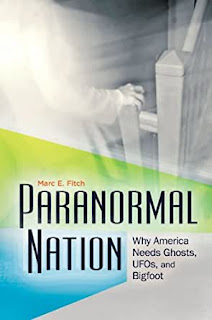Literature Review #4
Fitch, Marc E.. Paranormal Nation: Why America Needs Ghosts, UFOs, and Bigfoot, ABC-
CLIO, LLC, 2013. ProQuest Ebook Central, http://ebookcentral.proquest.com/lib/rutgers-
ebooks/detail.action?docID=1183924.
I mainly focused on Chapter 7, “The Rise of Paranormal Television.” This chapter talks about the popularity of paranormal programming. In this chapter, Fitch suggests that people are drawn to paranormal programming because they are fascinated by the conflict and mystery between science and the paranormal. He talks about how the balance between science and the paranormal is essential in paranormal television because actually proving the existence of the paranormal would lead to an end in such programming, but only showing the scientific side (i.e., that the paranormal does not exist) would make television less entertaining. Fitch further argues that science does not stand a chance when faced with paranormal programming, as it is impossible to debunk everything within the small window of time that scientists are given and that the burden of proof should not fall on scientists to prove that ghosts do not exist, but on paranormal programming to provide more evidence than just eyewitness testimony and possible coincidences.
Marc E. Fitch is the author of several horror novels as well as nonfiction books like Paranormal Nation: Why America Needs Ghosts, UFOs and Bigfoot and Shemexperts: How Power Politics and Ideology are Disguised as Science. He has a Master of Fine Arts degree from Western Connecticut State University. As a fairly successful author, Fitch must do a significant amount of research in order to publish his books. As he is known for his horror stories, he has researched the paranormal (and why it does not exist but still remains popular).
One key term is “paranormal programming,” which simply refers to radio or television shows that are centered around the paranormal, such as psychics, ghosts, aliens, etc. Another key term is “pseudoscience,” which refers to claims that are not scientific but present themselves as such. A key characteristic of pseudoscience is “the nonfalsifiable or irrefutable hypothesis. This is a hypothesis against which there can be no evidence—that is, no evidence can show the hypothesis to be wrong” (Fitch 134).
Quotes
1. “The mystery and the conflict between the paranormal and science is what draws the audience. It appears that while the intention of these programs may be to find and “prove” the paranormal, they silently acknowledge that to do so would mean the end of their programming, their jobs, and their income. Hence, it is a balance between the paranormal and the scientific that drives paranormal programming. If a show were to conclude without a doubt that ghosts are not real, they would probably lose the average viewer. It is the quiet hope that perhaps science may not have all the answers, the idea that science can’t disprove everything fantastic that maintains viewer interest. Though nothing has ever been proven scientifically on any of the paranormal programs, the idea that the paranormal could be true keeps people watching” (Fitch 131).
2. “The program, no matter how critical, leaves the viewer with a mystery and a dilemma—to believe the word of a seemingly reasonable, normal person or to believe science that has, thus far, been unable to prove the existence of said phenomena. The beauty of this style of paranormal programming is that science rarely stands a chance against the word of the witness or witnesses featured in the program” (Fitch 133).
3. “The problem is a matter of timing, coincidence, and the burden of proof. Firstly, the scientists have a very limited window of time in which to try to prove or refute a paranormal claim; they must do so while the cameras are rolling. Witness testimony requires no cameras or timing. It is often a thing of coincidence; a couple is walking through the woods and spots a Sasquatch. This is a fantastic coincidence that could take decades for science to replicate, thus science is given a small window of time to explain the unexplainable. Scientific explanation is automatically given the lower hand by means of timing, and as a result, the viewer is left believing that maybe this is a phenomenon beyond the abilities of modern science” (Fitch 133).
This source is useful because it explores why paranormal programming has become so popular. It also explains how and why science is given a lower priority than paranormal pseudoscience in entertainment. It also offers a unique view on how there must be a balance between science and the paranormal in paranormal programming. As my research question is about paranormal programming and science, this source covers a lot of background information and offers insight into my actual question as well.

Comments
Post a Comment